How to Choose a Heavy Bag: The Ultimate Heavy Bag Guide
Posted by Revgear on Jun 9th 2018
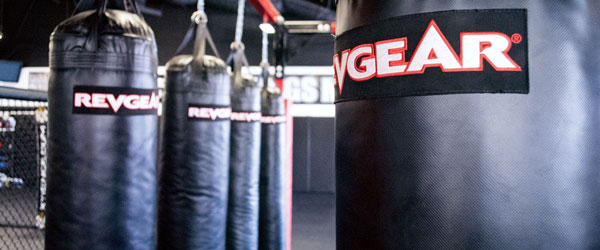
A heavy bag is a must-own piece of equipment for anyone who trains in fight sports. It’s also an incredibly useful item for virtually any type of athlete, helping to improve aerobic fitness, power, coordination, and core stability. Hitting the bag is also a great way to blow off some stress.
Not all punching bags are the same, so it’s important that you know how to choose a heavy bag that’s ideal for your goals. Read this comprehensive heavy bag guide so you can make an informed decision.
1. Single-Ended Bags
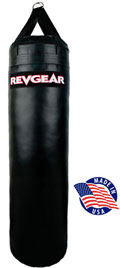
The single-ended bag is the most classic heavy bag style. “Single-ended” means that the bag hangs only from the top, allowing the bag to swing more freely than a double-ended bag, which is secured at the top and bottom.
As you learn how to choose a heavy bag, you’re going to find that how a bag responds to a hit makes a major difference in your overall workout. Single-ended bags are arguably the most versatile option. They swing back, but they don’t snap back as quickly as double-ended bags. This allows you to work on your technique and really hone in on the details for each and every hit.
The Revgear single-ended bag is the most traditional punching bag style. If you’re looking for a solid performer for everything from kickboxing to traditional boxing, it’ll do the job right. It’s a great choice for those who want to be able to practice a wide range of disciplines.
2. Double-Ended Bags
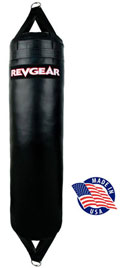
Next on our heavy bag guide is the double-ended bag. Double-ended bags are similar to single-ended bags, with the major difference being that in addition to securing at the top, they also secure to the floor from the bottom of the bag.
So what does securing the bottom do? Quite simply, it makes the bag hit back. A single-ended bag has more swing to it; it will come back towards you, but come back slowly. A double-ended bag, however, swings back faster thanks to the tension provided by the lower straps.
As you learn how to choose a heavy bag, you’ll see that your workout style plays a major role in determining which style is right. For example, if you’re training to hit fast and respond to real-time movements, a double-ended bag is a great choice. Revgear’s double-ended bags are also excellent for working on precision, as they bounce back to the same position after every hit.
3. Striker Bags
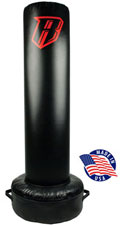
Strikers bags have a heavy base at the bottom, that keep them securely in place without relying on straps. That means you don’t need to worry about drilling holes in the ceiling or floor –– just set it up and you’re good to go. Some striker bags require that you fill the base with sand or water, but Revgear’s striker bag is good to go right out of the box.
Striker bags are ideal for those who want to work on their rhythm and timing, as they do snap back, but the speed of the return varies based on your power. They’re also excellent for working on accuracy and precision, as you need to be able to gauge how it’s going to respond on the fly. Last but not least, another key benefit of the striker bag? They’re portable!
4. Youth Striker Bags
As you might expect, youth striker bags are similar to adults-sized striker bads, only smaller. The youth striker bag from Revgear is 5-feet in height, perfect for younger athletes or those who are smaller in stature. A youth striker bag can also be a great addition to your training facility if you want to work on lower kicks.
5. Uppercut Bags
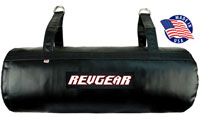
Finally, as you learn how to choose a heavy bag, you need to think about what types of punches and kicks you perform most regularly, as well as what your goals are for training in the future. As the name implies, uppercut bags are perfect for working on uppercuts and other strikes that start at waist level and travel under the chin area.
Uppercut bags are mounted horizontally, and they hang around head level. Revgear’s uppercut bag uses two heavy duty mounting straps to ensure that it remains securely in place, even during a high-octane workout. Naturally, due to the nature of the bag’s design, uppercut bags aren’t deal for working on your kicks. These types of specialized bags are incredibly useful, but only if you actually want to work on that specific style of fighting. For many athletes, an uppercut bag is a complementary piece of equipment alongside more traditional upright heavy bags.
Which Heavy Bag Is Right for You?
When it comes to understanding how to choose a heavy bag, you need to analyze a number of factors. First, what is your fighting style? If you want to be able to practice a wide range of martial arts disciplines, a single-ended bag is a solid choice. A double-ended bag is a great choice too, as long as you can handle the fast snap-back.
Striker bags are also quite versatile, especially because they can be transported as you need. If you travel with your gear, a striker bag (or a youth striker bag) is perfect for you. If high punches are your cup of tea, you may want to look into an uppercut bag. However, if this is your first and only bag, you might want to start with a more traditional option and work up from there.
Quality Matters
Now that you’ve read this full heavy bag guide, you should have an idea of which type fits your personal needs. Now, the next step is choosing a bag. Revgear heavy bags are trusted in the fitness community, offering exceptional quality at a very competitive price point.


